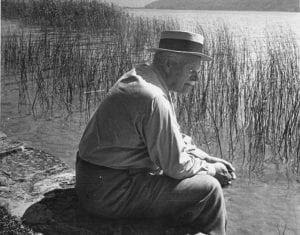Frederick Spielbergjet: Memory of C.G. Jung:
It was a colossal privilege for me to have been entitled to have several long talks with Jung.
In 1949, in Sikkim, I had discovered and acquired fourteen different types of Tibetan ghost traps, used for astrological, medical, and other reasons.
In Zurich I constructed a model of one of them.
This ghost trap I brought to Dr. Jung, because I knew he would be very interested in it. That was in the year 1956.
I brought it to him to his house in Kusnacht and he kept it, afterwards, in his tower, his big tower at Bollingen which is still in existence.
Now this ghost trap that I built I took with me to the railroad station on my way to Jung's place, and while I was waiting for the train with this huge thing at my side a man walked by and lifted his hat as if in respect to this thing he considered as at least a personality of dignity.
And then I talked to Dr. Jung and I told him this was one of my Tibetan ghost traps heel heard about, and the first thing he said was, "Have you trapped any ghosts with it yet?"
I said, 'Tm very surprised, Dr. Jung, that you as a psychologist ask such a question because we came to talk about the fact that obviously I would not have trapped a ghost with this contraption in Zurich because if there are any ghosts, and there may be some in Zurich and around the Jung Institute, these ghosts would not be the same as the Tibetans are accustomed to and for which purpose these particular contraptions were built."
But he was so interested in them and had many similar questions about their use and talked to me for a long time about somewhat related practices of village wizards in the Swiss villages, call "Strondel."
How many demons are there that can be trapped?
Usually the answer is that there are about 50,000, but if you ask about it closer you find out that each Tibetan has his own 50,000.
That makes quite a few billions!
Dr. Jung and I talked about that.
Why this enormous number?
Because we are maybe brought up as monotheists, it's a good thing to put all good things into one pot and call it God or all the bad things in one pot and call it the Satan.
Why so many?
Dr. Jung was very much in favor of polytheism in this sense because he said that every situation calls for its own demon and for its own projection.
It's much better if for every good occasion or for every bad occasion you have a separate angel and a separate ruling force that you can contact with instead of by mentalization to throw it all together in some abstract way.
One ghost trap was of special interest to Jung.
I told him that it was used to counteract the evil consequences of great success. "Of course," said Jung, "
You know, when somebody comes to me and boasts about the great success of his latest book I look deeply into his eyes and say, 'I hope, my friend, that this success will not harm you too much.'"
The last one of our conversations, in 1960, centered around the question of the decay of myth and religion.
To Jung's question, "What was your most recent publication about?"
I answered: "Alchemy as a way to salvation, in which I showed that the intellectualization of alchemy by Paracelsus and Boehme meant the death of alchemy.
Thereupon Jung said smilingly, "But I am an alchemist and I am not dead!"
The following discussion centered about this subject matter.
Jung, who had studied more medieval alchemy texts than anyone else, insisted that alchemy had not really died during the wrongly called "enlightenment," which relied one-sidedly on the material side of the exploration of Being.
In contrast to us, the alchemist did not feel body and soul as separated as we feel; the outside and the inside of his being were not
antagonistic.
If he faced a problem he went straight away down to his laboratory to find the solution by working with the materials of nature rather than to develop theories in his mind alone.
The problem he experienced thus has an aspect of the cosmic cycle that could be solved only in harmony with All.
His subconscious was not as subconscious as ours, his consciousness not so conscious.
So Jung became an alchemist, a harmonizer and combiner.
You will understand therefore when today I walk into a Jung Institute I do not feel that I am approaching just another psychiatric clinic where a few hundred people are helped in their personal suffering, but I have distinctly the impression of entering an alchemical laboratory, where the treasures of the deep are lifted up to the level of awareness.
Jung indeed was like a deep-sea fisherman who did not hesitate to touch, catch and accept the often beastly and dangerous, but also precious and wonderful essences that underlie our existence. ~Frederick Spiegelbergjet, J.E.T., Pages 83-85
Carl Jung across the web:
Blog: http: http://carljungdepthpsychology.blogspot.com/
Google+: https://plus.google.com/102529939687199578205/posts
Facebook: Group: https://www.facebook.com/groups/56536297291/
LinkedIn: https://www.linkedin.com/grp/home?gid=4861719&sort=recent&trk=my_groups-tile-flipgrp
Facebook Page: https://www.facebook.com/Carl-Jung-326016020781946/
Pinterest: https://www.pinterest.com/purrington104/
Red Book: https://www.facebook.com/groups/792124710867966/
Scoop.It: http://www.scoop.it/u/maxwell-purrington
Twitter: https://twitter.com/MaxwellPurringt
WordPress: https://carljungdepthpsychology.wordpress.com/
Great Sites to visit:
1. Jenna Lilla's Path of the Soul http://jennalilla.org/
2. Steve Jung-Hearted Parker's Jung Currents http://jungcurrents.com/
3. Frith Luton's Jungian Dream Analysis and Psychotherapy: http://frithluton.com/articles/
4. Lance S. Owens The Gnosis Archives http://gnosis.org/welcome.html


No comments:
Post a Comment